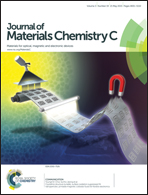Electrochemical composite deposition of porous cactus-like manganese oxide/reduced graphene oxide–carbon nanotube hybrids for high-power asymmetric supercapacitors†
Abstract
This paper proposes a simple, one-step, two-electrode electrochemical composite deposition for fabricating amorphous manganese oxide/graphene–carbon nanotube (a-MnOx/rGO–CNT) hybrids. The a-MnOx/rGO–CNT hybrids were simultaneously deposited onto steel substrates by using dodecylbenzene-sulfonic acid and controlling the cell voltage. The cell voltage affected the deposition rates of manganese oxide (driven by the concentration gradient) and carbon materials (driven by the potential gradient). The mass ratio of a-MnOx to rGO–CNT, controlled by the cell voltage, affected the morphology, microstructure, and capacitive behavior of a-MnOx/rGO–CNT. Under the optimal cell voltage (=1.25 V), an a-MnOx/rGO–CNT electrode exhibited a cactus-like a-MnOx nanostructure, an even dispersion of a-MnOx within the rGO–CNT, and a highly porous structure, yielding the highest outer charge (296.5 C g−1 cm−2) among all a-MnOx/rGO–CNT electrodes. In addition, a-MnOx/rG-CNT1.25V exhibited a high specific capacitance (440 F g−1 at 5 mV s−1) and excellent capacitance retention (60% at 1000 mV s−1). An asymmetric supercapacitor consisting of a commercial activated carbon negative electrode and an a-MnOx/rGO–CNT1.25V positive electrode provided a high specific energy (SE) of 18 W h kg−1 at a specific power (SP) of 1 kW kg−1. The SE of this asymmetric supercapacitor reached 5.1 W h kg−1 at a very high SP of 32 kW kg−1.


 Please wait while we load your content...
Please wait while we load your content...